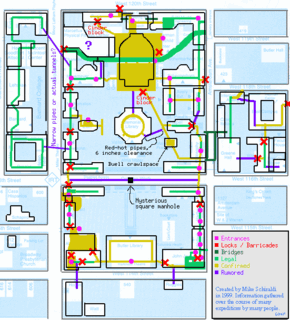- Columbia University tunnels
-
Columbia University has an extensive tunnel system connecting most buildings on campus and acting as conduits for steam, electricity, telecommunications, and other infrastructure. The oldest tunnels are from the mental asylum that existed before the Morningside Campus was built.[1] These tunnels are small and extremely hot, and they connect to Buell/La Maison Française, the one building remaining from the asylum. The steam tunnel system between Hamilton, Kent, Philosophy, and Fayerweather connects to these old tunnels.
Another steam tunnel system connects Mudd, Uris, Dodge Fitness Center, and Havemeyer, and is generally considered the easiest to access. These tunnels contain old rail tracks that were used to transport coal for heating.[2] They also contain the "Signature Room," where one can find many quotes and names left by previous tunnelers. As with all tunnels on campus, these contain many more secrets for students to discover. This tunnel system also used to connect to the first floor of Pupin Hall, but that way was blocked in the 1990s.
Until the Summer of 2003, the first floor of Pupin was virtually untouched from the last days of the Manhattan Project. Notes and daily logs scattered dusty tables. Half-completed experiments sat in stasis, only visible to the few explorers who got in. Since 2003, the first floor has been cleaned out, and is now mostly empty. This floor used to house one of the first cyclotrons until Spring 2008, when the cyclotron was removed and destroyed in order to make room for the infrastructure leading to the Interdisciplinary Science Building (currently under construction).[3]
Another tunnel system connects Havemeyer, Math, Lewisohn, and the Miller Theater. Tunnels also connect Butler, Carman, Lerner, and supposedly Furnald and Hogan. John Jay/Hartley/Wallach can also be reached from this system, but the door is locked, and the tunnels connect to JJ's Place, making exploration difficult. A tunnel between Butler and Low is rumored to exist, but no evidence of such a tunnel has ever been found. Any entrance to this tunnel from Butler is well hidden or heavily locked, and the Low entrance would be next-to-impossible to find given that Campus Security is based on the first floor. There are no tunnels across Broadway to the Barnard campus, although Barnard has its own set of tunnels and sub-basements. There are no tunnels across Amsterdam Avenue to East Campus: however, the subterranean garage deep below the School of International & Public Affairs does have tunnels leading to the dormitories and the Law School.
History
During the 1968 student strike, student staff at WKCR, Columbia's radio station, used the tunnels to tap the university's telephone system. Students also made use of the tunnels to travel between buildings occupied by strikers.
The names of students and alumni who have visited the tunnels appear scrawled throughout the tunnels. Ken Hechtman is one of the most infamous former Columbia tunnelers. In 1986, he led an underground group of tunneling students called AD HOC (Allied Destructive Hackers of Columbia). Hechtman was expelled during his first year at Columbia for stealing Uranium-238 from Pupin Hall, along with many dangerous chemicals from Havemeyer Hall.
The crawlspace runs beneath La Maison Française, which is the campus' French building. The building is the oldest on campus, serving as the warden's house in the Bloomingdale Insane Asylum during the late 19th century.
References
- ^ Duncan, Steve (July 20, 2005). "Old Coal Hoppers, Columbia University". Undercity.org. http://www.undercity.org/photos/1Gallery/CU_hoppersfront2.htm. Retrieved August 10, 2006.
- ^ Duncan, Steve (July 20, 2005). "Columbia University: Old Physical Plant Tunnels". Undercity.org. http://www.undercity.org/photos/Columbia/index.htm. Retrieved August 10, 2006.
- ^ Duncan, Steve (March 31, 2006). "Finding History In Radioactive Storage Rooms". Undercity.org. http://www.undercity.org/photos/CriticalSpaceEquip/index.htm. Retrieved August 10, 2006.
- http://www.wired.com/wired/archive/1.03/tunnelers.html
- http://www.ivysport.com/category-category_id/331
- New Yorker Magazine, Volume 65, p. 28
External links
Categories:- Columbia University
- Tunnels in New York City
Wikimedia Foundation. 2010.

